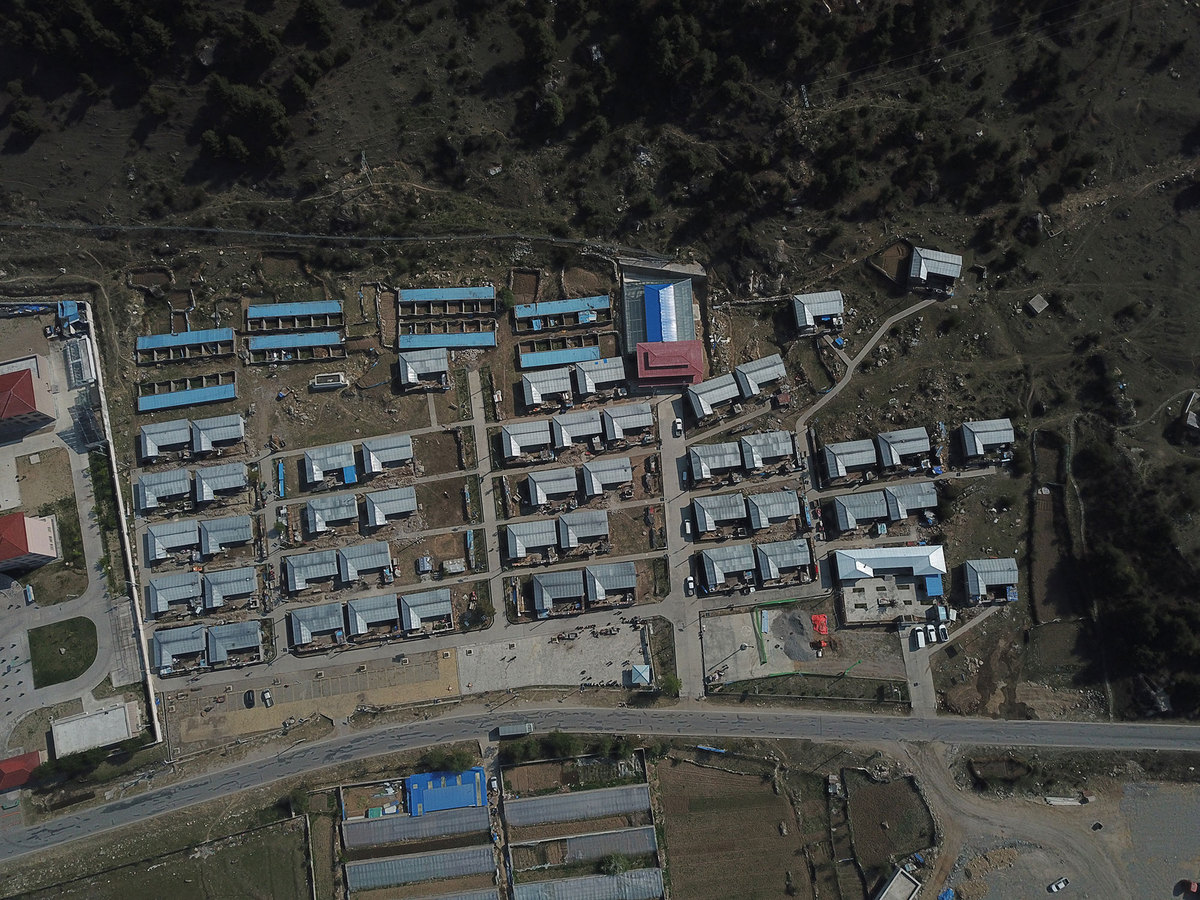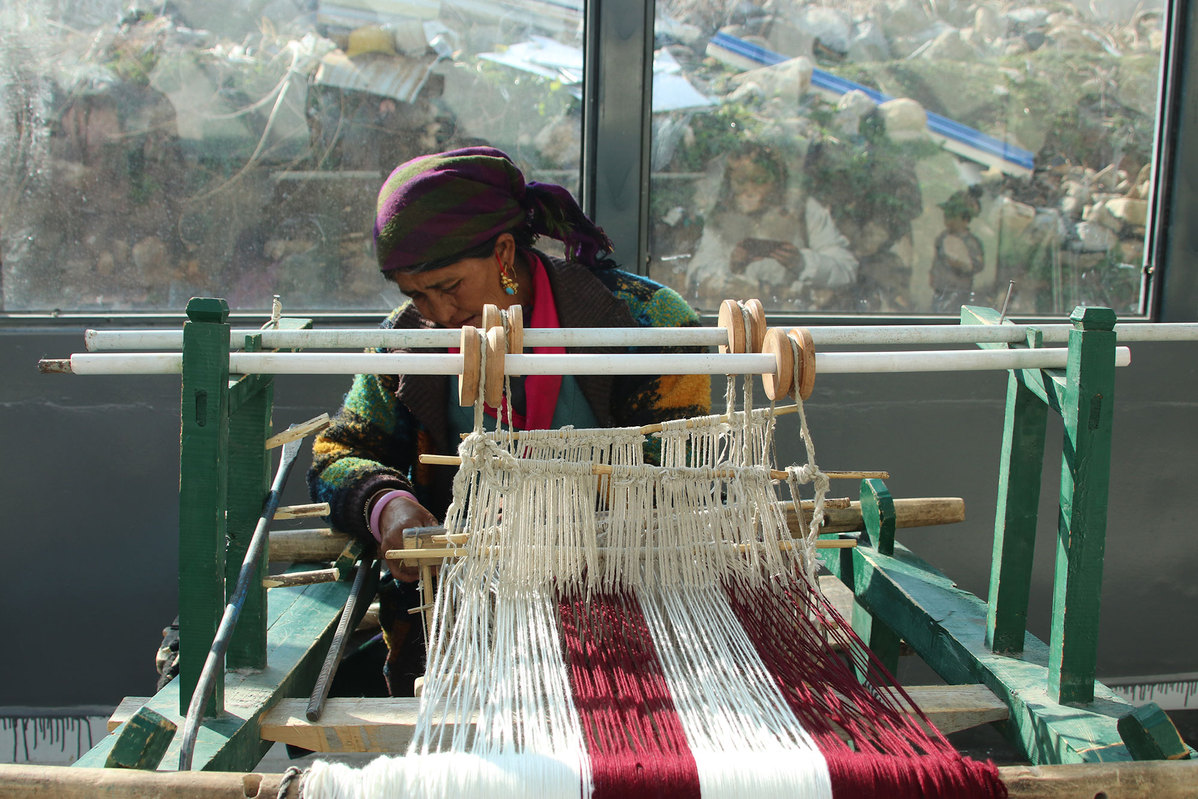 Da Mag village on China-Nepal border in Southwest China’s Tibet holds a flag-raising ceremony on May 14, 2019. [Photo by Li Jin/Provided to chinadaily.com.cn]
Da Mag village on China-Nepal border in Southwest China’s Tibet holds a flag-raising ceremony on May 14, 2019. [Photo by Li Jin/Provided to chinadaily.com.cn]
Ancestors were stateless for more than two centuries before the modern generation was awarded Chinese citizenship. Zhang Wenfang reports from Shigatse, Tibet autonomous region.
Nationality is usually something one acquires by birthright, but for a group of people who live in the Tibet autonomous region near China's border with Nepal, it is a gift from the government that has completely changed their lives.
They are members of the Da Mag group. Da Mag means "cavalry" in the Tibetan language.
They were stateless until 2003, when China accepted them as citizens and founded their village, also called Da Mag, in Gyirong county, Shigatse city.
According to legend, the villagers are descended from a Gurkha cavalry unit that was part of a large force sent by Nepal to invade Tibet from 1788 to 1792. However, the unit was defeated by an army dispatched by the Qianlong Emperor of the Qing Dynasty (1644-1911) and its members were unable to return home.
For six to seven generations, the Da Mag people intermingled with the local Tibetans, picking up their language, customs and culture. But one problem - a lack of nationality - made their lives extremely hard and inconvenient.
 A bird's-eye view of Da Mag village on China-Nepal border. [Photo by Li Jin/Provided to chinadaily.com.cn]
A bird's-eye view of Da Mag village on China-Nepal border. [Photo by Li Jin/Provided to chinadaily.com.cn]
Turning point
Dradul's chance came on May 26, 2003, when the State Council, China's Cabinet, officially approved the Da Mag people's application for citizenship.
Forty-seven households with 86 people were issued with identity cards and household registration documents, known as hukou, which confirmed they were now officially Chinese.
It's difficult to trace the start of the process, but one thing that is certain is that a woman named Dekyi, who was a high-level official in the Shigatse government, played a key role in the people's naturalization.
After that, an entirely new settlement - Da Mag village - appeared in Gyirong county, and sweeping changes have taken place in every aspect of the people's lives.
"I was thrilled and extremely happy to hear that we had got Chinese citizenship, which meant we could go to school and be treated equally," said Dradul, who was 11 years old when he became a Chinese citizen.
Supported by the government, he finished nine years of compulsory education in 2012.
Later, he was one of the first three students from the Da Mag group to leave Tibet and study in the northeastern province of Jilin, which boasted higher-quality educational resources. After graduating from Tonghua Normal University, he returned to the village and became a kindergarten teacher.
Today, every school-age child in the village is enrolled in the education system.
From preschool to senior high school, compulsory education now lasts 15 years, and if a Da Mag person gains a place at a university, he or she receives subsidies and are exempt from paying fees.
Their parents all own houses, too. In 2004, the regional government spent 1.47 million yuan to build homes for all the households in the village, which numbered 49 at the time.
On Sept 18, 2011, the village was severely damaged after an earthquake in nearby India. In response, a 5.64 million yuan post-disaster reconstruction project was started to rebuild every house and strengthen the roads.
In addition, a small square, rows of cowsheds and 14 vegetable greenhouses were built, and solar-powered street lamps were installed.
As border residents and herdsmen, the villagers receive living subsidies every year. Since 2016, villagers ages 16 to 65 have been offered environmental protection jobs as part of the nation's efforts to eradicate poverty.
In total, each adult villager can claim an annual allowance of about 10,000 yuan through government subsidies.
Moreover, they can seek jobs in places they could not reach before, such as Shigatse, Lhasa, the regional capital, and even cities farther away in provinces such as Sichuan or Gansu. Those who stay at home can find work as truck drivers, collectors of medicinal herbs, craftsmen or porters.
The village is now home to 195 people in 58 households, and every resident is covered by basic medical insurance and endowment insurance.
 A woman weaves Tibetan blanket on a loom in the newly built workshop for ironware-making and fabric-weaving in Da Mag village, Gyirong county, Shigatse city, Southwest China’s Tibet autonomous region, May 11, 2019. [Photo by Zhang Wenfang/chinadaily.com.cn]
A woman weaves Tibetan blanket on a loom in the newly built workshop for ironware-making and fabric-weaving in Da Mag village, Gyirong county, Shigatse city, Southwest China’s Tibet autonomous region, May 11, 2019. [Photo by Zhang Wenfang/chinadaily.com.cn]
Better homes, better lives
Rows of neat gray buildings stand against green hills, while bright-red national flags and colorful prayer flags flutter in the crystal-blue sky. Concrete paths are connected to the asphalt roads. Inside the houses - whose average living space is 96 square meters - Tibetan furniture and household appliances serve people's daily lives.
When Da Mag village was founded 16 years ago, the residents would never have imagined that such scenes were possible.
The village continues to evolve. This year, 3 million yuan has been allocated for further home improvements, enabling doors and roofs to be replaced with more-solid, stronger ones, and fences are being renovated.
Recently Tashi Dhodrub entered a new phase of his career as a blacksmith by recruiting about 15 apprentices.
He is excited about the future, because at the end of the month he will bid farewell to his old workshop, a converted cowshed, and move into a spacious two-story building.
The old workshop is narrow, dirty and poorly ventilated. The tools are primitive; just a hammer and a simple hand-powered forge.
In the new workshop, the apprentices will work with more productive equipment. The building was erected last year to serve as a center for handicraft training classes and to provide workshops for blacksmiths and weavers.
In October, the weavers became the first group to move in and start working on newly-installed looms.
A handicraft cooperative involving 61 craftsmen and women has been established to develop the collective economy, create jobs and help the poor.
"We gather jobless women together and train them as weavers. One Tibetan blanket can sell for 400 to 500 yuan and Tibetan quilts can reach 800 yuan each," said Dawa, a female cadre in the village.
"In this way, the women, mostly stay-at-home wives, can work and earn some money in their own houses and take care of their family at the same time."
Yungdrung, Party secretary of Da Mag, said: "The village still has nine impoverished families, a total of 22 people. All of them are participating in the handicraft cooperative, learning to be blacksmiths or weavers.
Tashi Dhodrub said: "China has given us a home. With the government's support, our village is developing and changing day by day. Now, we must rely on our own efforts to create an even better life. I believe we can do it."

